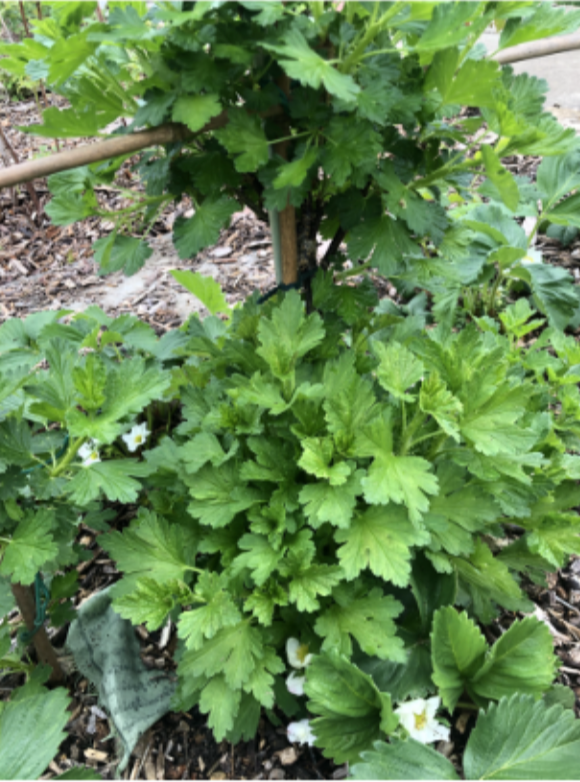June 2021
Cold drought, to swamp conditions to full blown heat and sun. This has not been an easy growing year. May’s wetness and subsequent slug invasion has pretty much finished off the courgettes and beans. There are things you can do to deter slugs. Beer traps, copper wire, broken egg shells and of course chemical pellets to name a few. I stopped using pellets many years ago. The Government has issued a ban on the outdoor use of metaldehyde slug pellets (the blue ones), to be introduced across Great Britain from spring 2022; these slug pellets linger in the dead slug and can poison other wildlife notably hedgehogs. The chemicals work to prevent the slug generating slime, so as soon as it rains they are rendered pretty useless anyway.
Leeks:
Unperturbed I planted out the leeks. They are quite fragile and need careful handling but make for a long crop throughout Autumn and Winter.

This tray of leeks was grown in the potting shed. Prepare a fertile well tilled bed. Damp it down so the soil stays in position. Place some dibbed holes about 10cm apart and about 15 cm deep. I use the handle of a trowel for this. If the hole collapses, wet the soil down a little more.
Separate out the individual plants and carefully place the tread root system in the dibbed hole. Water in the root with a watering can. Soil will wash down and submerge the root.
You should end up with a delicate field of grassy like stems. They will need watering carefully daily, particularly if there is full sun. I also put a low net over the bed to stop the birds from undoing all my hard work.
Gooseberries:
Gooseberry seems to be going out of fashion but I grew up on them and still like the tartness particularly with ice cream. They are pretty easy and robust plants tolerating most soil types. However, they suffer from two notable problems. Sawfly and mildew. Sawfly is a low flying insect so if you can raise the structure of the plant away from the ground with pruning it can help reduce the fly’s ability to lay eggs on the leaves. The caterpillars strip the plant from base to top eventually killing it. For this reason I am shaping the bushes into vertical cordons and have removed all the basal growth to promote upper expansion. The disadvantage is that they will need some form of support. Another option is to cover the bushes in ash, which the flies dislike. The ash will also act as a fertiliser. The open structure of the cordon helps to aerate the plant and reduces its susceptibility to mildew. If you just want bushes keep their centres open and clutter free by cutting out most of the central growth.

Hinnomaki red gooseberry with strawberries.
Stone Fruit:
Any fruit tree that bears stoned fruit can be pruned from late spring through into summer. This reduces the risk of Silver Leaf fungal infection. I am (sort of) fan training a Nectarine and an Apricot in the fruit cage. I say sort of because there were acquired as two year old trees with some significant structure of over six to ten branches. Ideally, you should start with a one year old maiden single stemmed whip. The leader, or the central growing stem is removed in the second year to allow space for the first two lateral branches. It is these two branches which provide the shape of the fan. There is a really good resource on https://www.kenmuir.co.uk/ explaining how to grow all sorts of soft fruit as well as how to prune and shape fruit trees which is wrongly considered a bit of a dark art to be avoided. Whatever pruning you do just make sure that the secateurs are really sharp and clean and sterilise them using anti fungicide spray when moving between trees. That way you wil minimise the risk of cross contamination. In my case I’m going to see if I can cheat a little and just control the size of the fan on six lateral branches. Here I am trimming down some of the spur growth to the second cluster of leaves. These are known as a basal nodes to hopefully concentrate fruit production.

Swiss Chard and Five Colour Chard:
These chards are really hardy and providing a great source of greens for various dishes including curries and pastas. Keep cutting away the young growth and it will generate more fresh young leaves. Take away damaged and rotting base growth to keep the plant healthy.

Swiss Chard Chard (Leaf Beet Five Colour)
Angus is a Senior First Officer and Resilient Pilot Mentor with a passion in Wellbeing, CRM and TEM. This is the sixth in a series of blogs from Angus, to read more click here. To find out more about Angus, and our other pilot mentors, please visit our 'supported' page

Comments